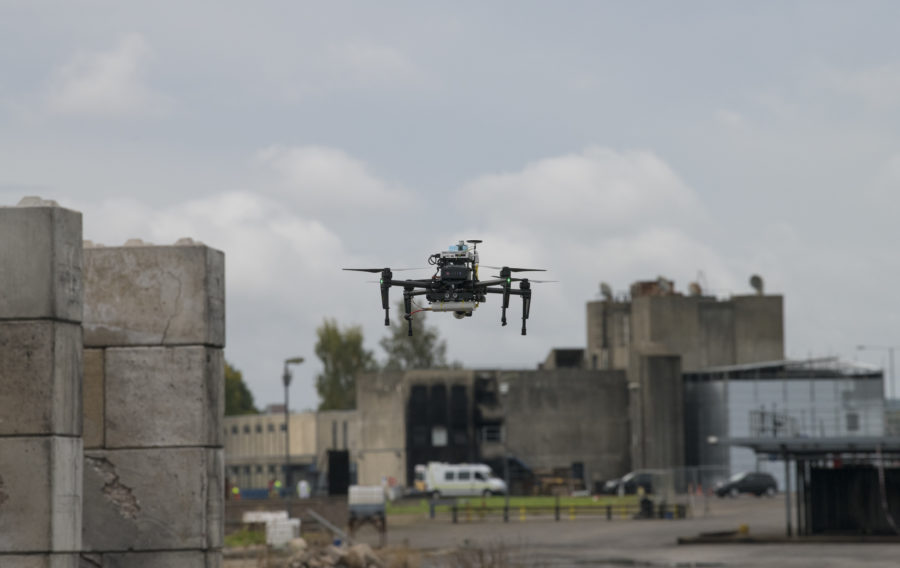
In autumn 2018, a cutting-edge armada of robots and drones, designed to test for chemical agents, provide 3D mapping and identify casualties, were put through their paces by soldiers, police officers and scientists for the very first time.
Co-funded by the Ministry of Defence and Home Office, this model army was made up of robots able to ‘read’ and climb stairs and miniature drones weighing less than a bar of soap, which could soon enter into service to rapidly assess potentially hazardous zones.
With this groundbreaking research, christened Project Minerva, the MOD hopes to reduce risk to emergency services and frontline troops as they attend incidents or operations involving hazardous chemical or biological materials.
The autumn trials took place at Gloucestershire Fire Service College and saw concept drones and robots thrown into simulated contamination scenarios in both homeland and battlefield environments. This technology was held up against the speed and accuracy of human response teams, with support from specialist Dstl (Defence Science and Technology Laboratory) scientists, the military, police and fire services.
“Following the reckless nerve agent attack in Salisbury, we have seen the bravery and professionalism of our Armed Forces, emergency services and MOD scientists,” said Defence Secretary Gavin Williamson. “They have worked tirelessly to investigate and clean up deadly contaminated areas. This project will ensure we stay at the forefront of dealing with such heinous attacks, whether on our streets or on foreign battlefields. We are investing millions in this pioneering technology to do more to protect those who so fearlessly protect us.”
Minister of State for Security and Economic Crime, Ben Wallace, added: “I am excited to see the UK being on the front foot and leading in the development of these autonomous technologies which are secure, reliable and useful for dangerous sites. The potential to protect our responders and protect the public from potentially hazardous scenes is considerable. The UK’s experience and pedigree in security means we are in a prime position to identify what is best placed to tackle the threats of the future.”
Project Minerva first launched in September 2016, and it has been allocated over £3 million in joint funding in the weeks and months since. The initiative aims to bring innovative designs from concept to reality in an accelerated timeframe. Those involved in the latest trials represent the winning concepts for Phase II of the project.
To date, Project Minerva has been led by Dstl. It has been jointly funded by the MOD’s science and technology (S&T) portfolio and the Home Office and contracted through the Defence and Security Accelerator (DASA), with additional funding from Defence Science and Technology (DST).
Phase I initially ran for six months until July 2017 and funded 18 development projects with a collective worth of £1.37 million. From these, four teams were shortlisted to develop their concepts further during the second phase. Just over £1.6 million in funding was awarded to the following Phase II winners, all of which are small or medium-sized enterprises (SMEs) or academic institutions:
- BMT Defence Services (with Rescue Global, Herriot Watt and Edinburgh Universities) for Red Alert, an unmanned aerial vehicle with gas-sensing technology and 2D and 3D mapping and modelling capabilities. This can be mounted on a commercially available drone to allow for upgrades as technology evolves.
- Horiba MIRA for a small purpose-built ground robot which can deploy on decontamination missions, climb stairs and ‘read’ or recognise hazardous chemical signs and symbols, exploiting cutting-edge neural network technology.
- Loughborough University (with Swarm Systems and Createc) for SceneSEARCH – a pocket-sized nano-drone weighing less than 250 grams with gas sensors and video and thermal imaging capabilities.
- Autonomous Devices Limited and Pendar for Snake Eyes, a unique hybrid air and ground vehicle optimised for confined spaces which can relay 3D images of a space and detect chemical agents using a compact laser system.
The trials themselves proved a positive experience. According to Dr Cunjia Liu, Principal Investigator on the SceneSEARCH project: “Loughborough was the lead for SceneSEARCH and developed the core technology for this project. We created an intelligent search algorithm which, based on the chemical sensor on the drone, can guide the drone to find the source of a chemical release.
“The trial in Fire Service College was a success and the drone was able to find the release source in an autonomous fashion or in collaboration with the operator – so we’re very happy and hope this technology can be eventually handed over to first responders.”
Now, the innovators will analyse the findings to ascertain how their concepts can be refined and iterated upon. As Peter Stockel, Dstl’s Autonomy Lead, concludes: “With continued involvement across government, and demonstration with the user community, we aim to mature this emergent capability to test the ‘art of the possible’ and accelerate this into the hands of the prospective users for further operational evaluation, both for MOD and the Home Office.”
Meanwhile, Defence Secretary Gavin Williamson has also announced measures to maintain the UK’s world-leading chemical analysis capability, having outlined £48 million worth of investment in a brand-new Chemical Weapons Defence Centre at Dstl, Porton Down. Crucially, the announcement demonstrates how seriously the Ministry of Defence is taking chemical detection, both at home and abroad.
If you would like to join our community and read more articles like this then please click here.
chemical detection drones Ministry of Defence Project Minerva robots






